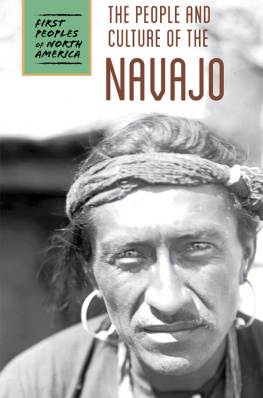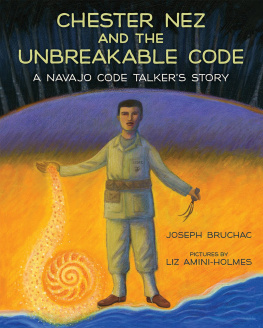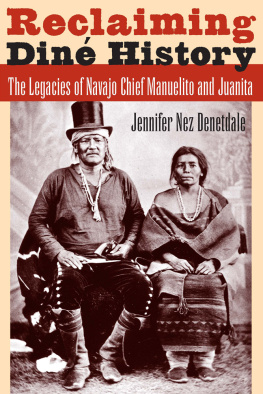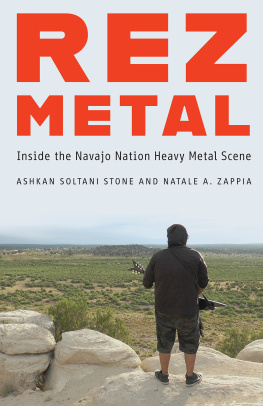Indian-Made
CultureAmerica
Erika Doss
Philip J. Deloria
Series Editors
Karal Ann Marling
Editor Emerita
|
| INDIAN-MADE | Navajo Culture in |
| the Marketplace, |
| 18681940 |
| Erika Marie Bsumek |
University Press of Kansas |
2008 by the University Press of Kansas All rights reserved
Published by the University Press of Kansas (Lawrence, Kansas 66045), which was organized by the Kansas Board of Regents and is operated and funded by Emporia State University, Fort Hays State University, Kansas State University, Pittsburg State University, the University of Kansas, and Wichita State University
Library of Congress Cataloging-in-Publication Data
Bsumek, Erika Marie.
Indian-made : Navajo culture in the
marketplace, 18681940 /
Erika Marie Bsumek.
p. cm. (CultureAmerica)
Includes bibliographical references and index.
ISBN 978-0-7006-1595-7 (cloth : alk. paper)
ISBN 978-0-7006-2394-5 (ebook)
1. Navajo IndiansCommerce. 2. Navajo
weaversHistory. 3. Navajo textile
fabricsHistory. 4. Trading postsSouthwest, NewHistory. I. Title.
E99.N3B86 2008
979.10049726dc22 2008020140
British Library Cataloguing-in-Publication Data is available.
Printed in the United States of America
10 9 8 7 6 5 4 3 2 1
The paper used in this publication is recycled and contains 30 percent postconsumer waste. It is acid free and meets the minimum requirements of the American National Standard for Permanence of Paper for Printed Library Materials Z39.48-1992.
Publication made possible, in part, by a University Co-operative Society Subvention Grant awarded by The University of Texas at Austin and the Charles Redd Center for Western Studies at Brigham Young University.
A portion of Chapter 4 was previously published in Erika Bsumek, Exchanging Places: Virtual Travel, Vicarious Tourism and the Consumption of Southwestern Indian Artifacts, in The Culture of Tourism, the Tourism of Culture: Selling the Past to the Present in the American Southwest, ed. Hal Rothman (Albuquerque: University of New Mexico Press, 2003).
Part of Chapter 5 was originally published as The Navajos as Borrowers: Stewart Culin and the Genesis of an Ethnographic Theory, New Mexico Historical Review 79 (Summer 2004): 319352. 2004 by the University of New Mexico Board of Regents. All rights reserved.
Portions of the Epilogue were originally published as Erika Bsumek, Value Added, in A. G. Hopkins, ed., Global History: Interactions between the Universal and the Local, 2006, Palgrave Macmillan, reproduced with permission of Palgrave Macmillan.
CONTENTS
Introduction
Navajos, the Navaho, and the Market for Indian-Made Goods
Chapter 1
Creating the Navaho
Chapter 2
Negotiating the Navajo Trading Post, Navigating the National Economy
Chapter 3
Marketing the Navaho through Frontier Commerce
Chapter 4
Dealing in and Consuming the Navaho, 18901940
Chapter 5
Authenticating the Navaho
Chapter 6
Codifying the Navaho: The Indian-Made Controversy
Conclusion
Branding, Borders, and Beyond
ACKNOWLEDGMENTS
In the course of researching and writing this book, Ive had the opportunity to work with a number of amazing people. Nothing pleases me more than to have this chance to thank all of those who have helped me complete this project. I am especially indebted to Peggy Pascoe, whose commitment to scholarship, students, and the craft of history make her an ideal role model. I can only aspire to be an equally dedicated, hardworking, and conscientious scholar. As a graduate student at Rutgers University, I was fortunate to work with Virginia Yans, Dee Garrison, and Susan Schrepfer. All of them provided insight and help at different times. I would especially like to thank Ginny for her efforts. Jan Lewis was also a wonderful mentor. As a fellow at the Rutgers Institute on Ethnicity, Culture, and the Modern Experience, I learned much from Clement Alexander Price, the very model of the scholar-citizen; I cannot thank him enough for his guidance and support.
Research took me to many locales and put me in contact with a number of extraordinarily helpful people. At the Huntington Library, Peter Blodgett always made time to help me locate materials that were crucial to the project; he is a generous archivist and a wonderful scholar, and I feel lucky to count him as a friend. The late Martin Ridge was always willing to read my drafts and give constructive advice. I am saddened that he did not get to see this book. I also want to acknowledge and thank Robert C. Ritchie for welcoming me into the community of scholars that he has created at the Huntington Library. He has been a wonderful mentor, and I am enormously grateful for his support. I owe thank-yous to Bill Frank and Jenny Watts for their assistance in finding material within the Huntingtons rich collections and for obtaining copies of archival documents. While I was at the Center for Southwest Research, Lou Hieb not only helped me find the documents I needed, but he read various drafts of my work in its earliest stages and always offered useful advice. Librarian Mary Tsosie provided assistance at a key moment. I am also thankful for the help of Theresa Salazar and Scott Cossell at the University of Arizona. At the Hubbell Trading Post in Ganado, Arizona, Ed Chamberlain and his staff responded to queries, helped me coordinate research trips, introduced me to a number of important contacts, and made my research in the area a pleasure. At the Brooklyn Museum, Deborah Wythe and Angie Park were as dedicated as any archivists could be and spent considerable time helping me track down the items I needed, both during the initial research and during the fact-checking stage. Jonathan Batkin, director of the Wheelwright Museum of the American Indian in Santa Fe, was an amazing resource. Not only did he direct me to material at the Wheelwright, but he shared items from his personal collection. I am also grateful to Cheri Frankenstein-Doyle for her input. I offer special thanks to scholar Willow Powers for sharing her research with me. I visited many other archival collections and would like to thank the librarians at the School for Advanced Research; the Cline Library; the National Archives and Records Administration in Laguna Niguel, California, Denver, Colorado, and College Park, Maryland; the Museum of Northern Arizona; the Montclair Art Museum; the Heye Museum of the American Indian; and the Mudd Library at Princeton University.
This project would not have been possible without generous financial support. I thank the following institutions for investing in this book: the Tanner Humanities Center at the University of Utah, the Huntington Library, the Charles Redd Center at Brigham Young University, the American Philosophical Society, the Geraldine R. Dodge Foundation, Rutgers University, and the Mudd Library at Princeton University. The University of Texas at Austin provided assistance through the Deans Fellowship program, the Scholarly Activities Grant program, and the Special Research Grant program. I spent a semester with a reduced teaching load as a fellow at the Humanities Institute on campus, a period that I needed and very much appreciated. Finally, the university awarded me a Co-operative Subvention Grant to help with the publication costs of the manuscript, and the Charles Redd Center provided additional subvention funds. I am also grateful to the editorial and production staff at the University Press of Kansas, including Nancy Jackson, Jennifer Dropkin, and Kalyani Fernando, for shepherding this project through the publication process and to readers Leah Dilworth, Marguerite Shaffer, Erika Doss, and Phil Deloria for providing such helpful suggestions for revision. Although I only met Adrienne Harris in the editing process, I am extremely grateful to her for all of her thoughtful suggestions.










